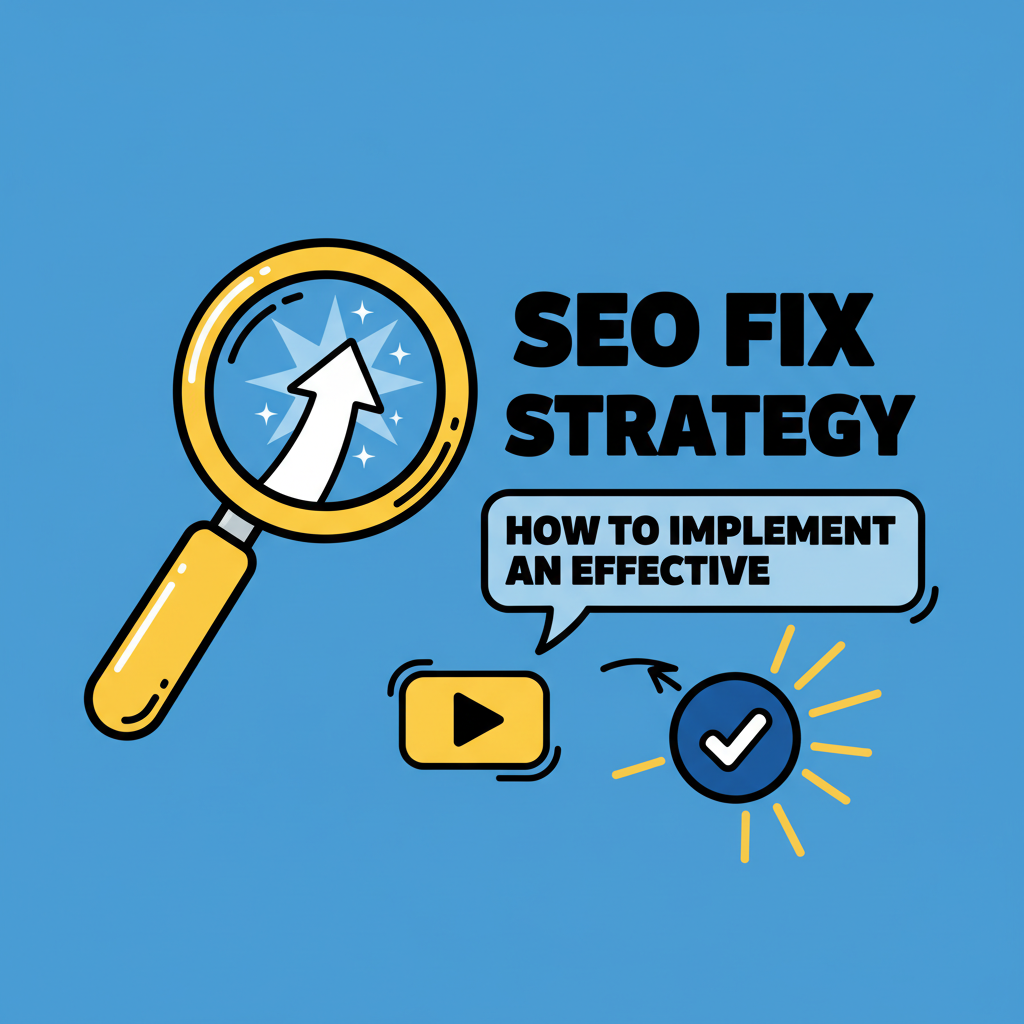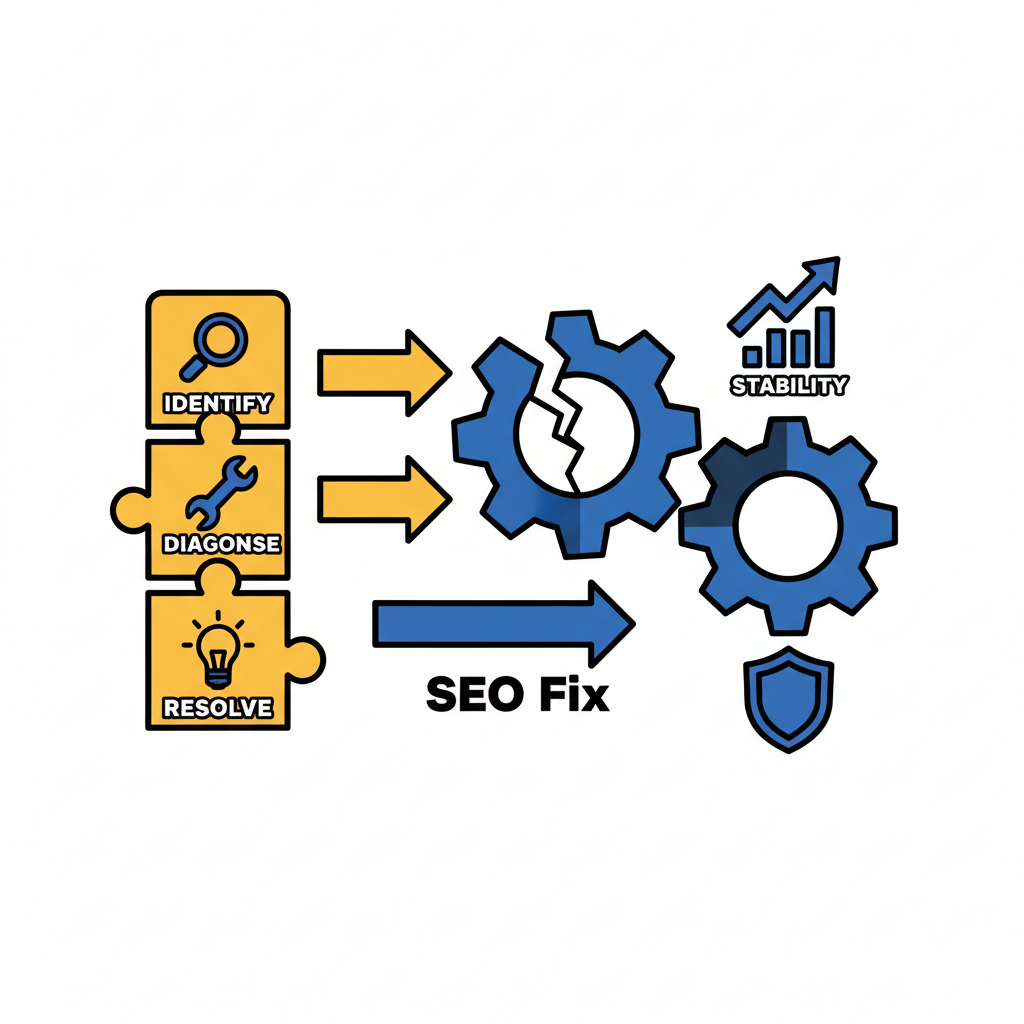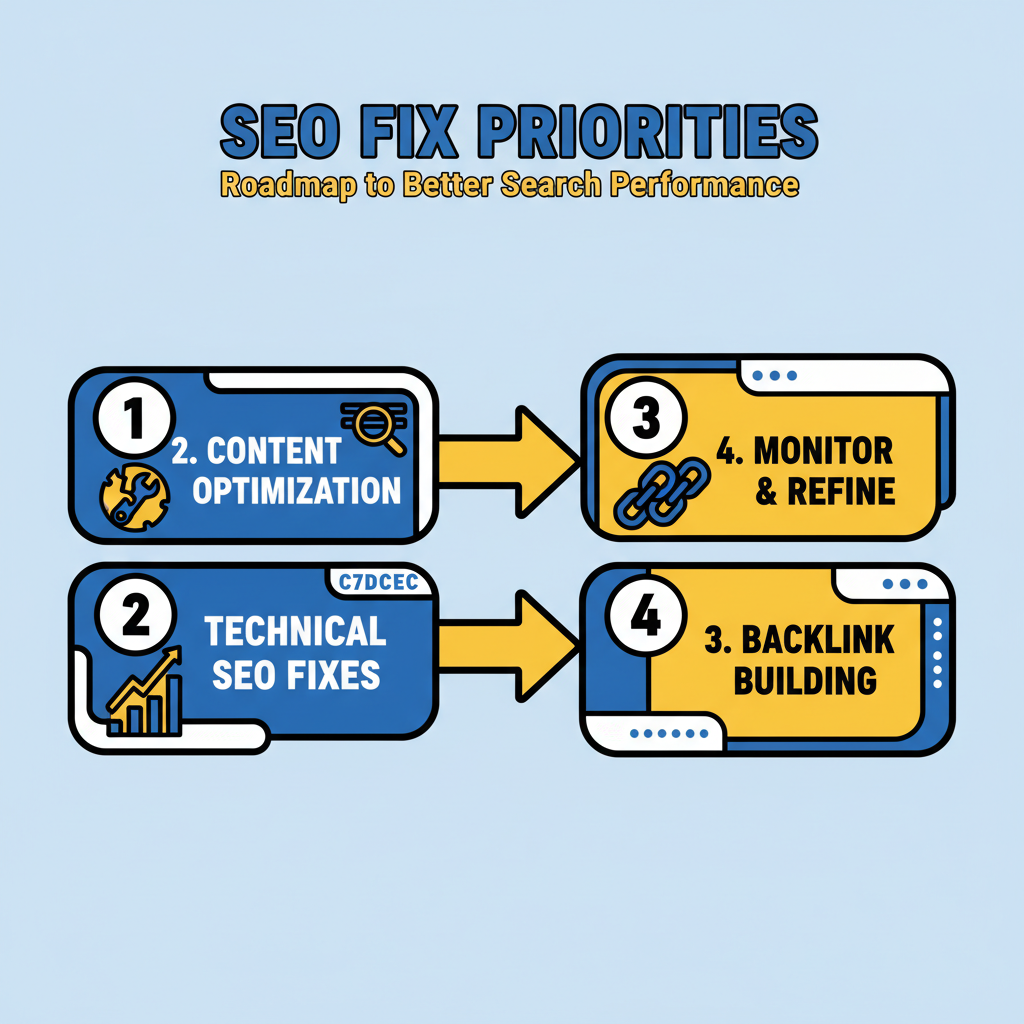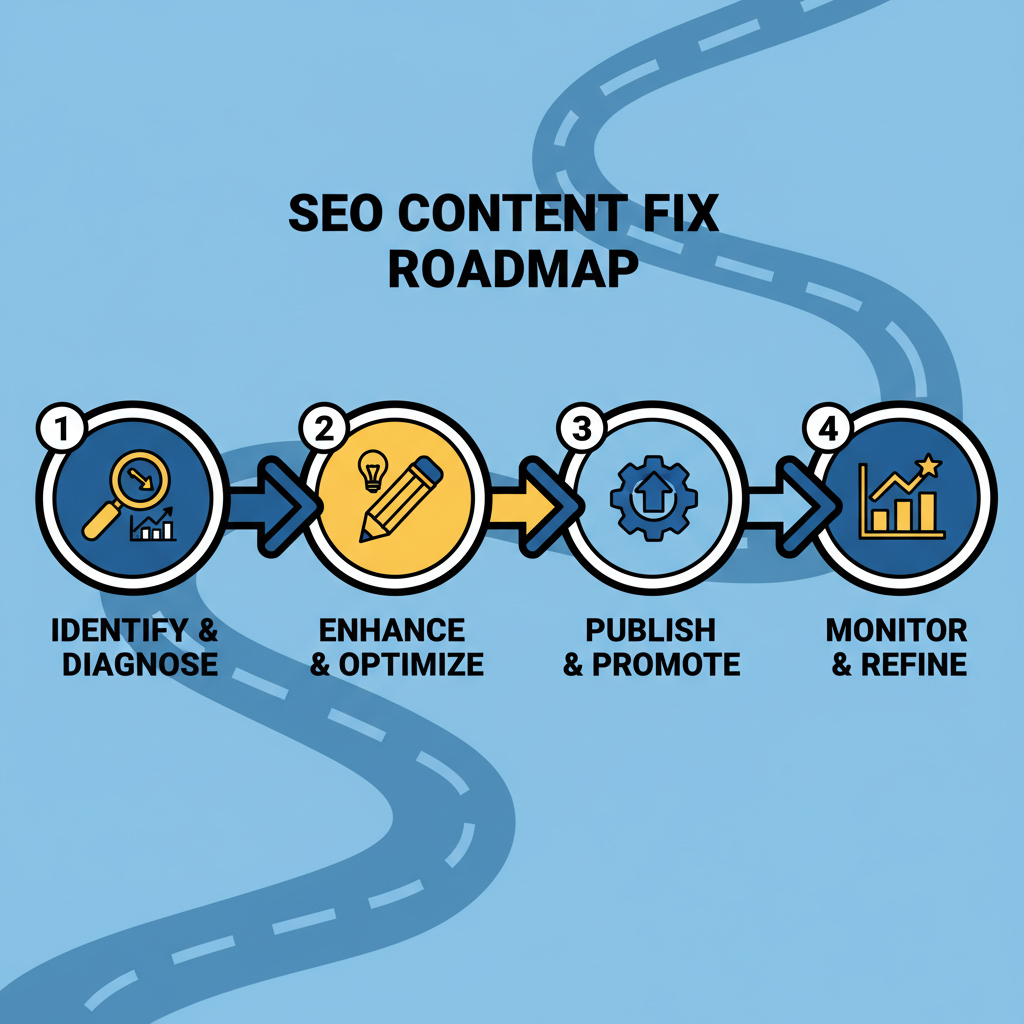How to Implement an Effective SEO Fix Strategy for Your Website
Posted by
How to Implement an Effective SEO Fix Strategy for Your Website

When your website's organic traffic drops or search rankings plummet, you need more than generic advice. You need a systematic SEO fix approach that identifies problems, prioritizes solutions, and delivers measurable results. This comprehensive guide walks you through proven methods to diagnose SEO issues and implement targeted fixes that restore your website's search performance quickly and effectively.
What Exactly Is an SEO Fix and Why Do You Need One?

An SEO fix refers to the strategic process of identifying, diagnosing, and resolving specific search engine optimization issues that prevent your website from ranking well or maintaining consistent organic traffic. Unlike routine SEO maintenance, an SEO fix targets acute problems that require immediate attention.
Most websites experience SEO issues at some point, whether from algorithm updates, technical problems, content gaps, or competitive pressures. The key difference between successful websites and struggling ones lies in how quickly and effectively they implement the right SEO fix strategies. Rather than applying broad optimizations, a targeted fix approach addresses root causes and delivers faster recovery.
Common scenarios requiring an SEO fix include sudden ranking drops, decreased organic traffic, technical errors affecting crawlability, or penalties from search engines. Each situation demands a specific diagnostic approach and tailored solution strategy.
How to Diagnose What SEO Fix Your Website Actually Needs?
Before implementing any solutions, you must accurately identify the underlying issues affecting your website's performance. This diagnostic phase determines which SEO fix strategies will be most effective for your specific situation.
Start by analyzing your Google Analytics and Search Console data to identify patterns. Look for sudden drops in organic traffic, specific pages losing rankings, or crawl errors that appeared recently. Export data covering at least the past six months to establish baseline performance and pinpoint when problems began.
Next, conduct a comprehensive technical audit using tools like Screaming Frog or similar crawling software. This reveals issues like broken links, duplicate content, missing meta tags, slow loading pages, and mobile usability problems. Document every issue with its location and severity level to prioritize your SEO fix efforts effectively.
Step 1: Analyze Traffic and Ranking Patterns
Begin your SEO fix process by examining traffic patterns in Google Analytics. Navigate to the Acquisition section and compare organic search traffic month-over-month. Identify which pages experienced the most significant drops and note any correlation with specific dates or events.
Use Google Search Console to review your average position, clicks, and impressions for target keywords. Filter data by page and query to understand which content pieces need immediate attention. This analysis forms the foundation of your SEO fix strategy.
Step 2: Conduct Technical Health Assessment
Run a complete technical audit to uncover issues that might be hampering your search performance. Check for proper XML sitemap submission, robots.txt configuration, and internal linking structure. Examine page loading speeds using Google PageSpeed Insights and identify opportunities for improvement.
Pay special attention to mobile usability, as Google's mobile-first indexing makes this a critical factor in your SEO fix approach. Test your website on various devices and screen sizes to ensure optimal user experience across all platforms.
What Are the Most Critical SEO Fix Priorities to Address First?

Not all SEO issues carry equal weight in terms of impact on your search performance. Prioritizing the right fixes ensures you address the most damaging problems first and see results more quickly from your efforts.
Technical issues typically take precedence because they can prevent search engines from properly crawling and indexing your content. Fix broken internal links, resolve duplicate content problems, and ensure your website loads quickly across all devices. These foundational elements must work correctly before other optimizations can be effective.
Content-related problems rank second in priority, especially if you've identified pages that previously ranked well but have since declined. Focus on updating outdated information, improving content depth and quality, and ensuring proper keyword optimization without over-optimization penalties.
| SEO Fix Priority | Issue Type | Expected Impact | Time to See Results |
|---|---|---|---|
| Critical | Technical errors, site speed | High | 2-4 weeks |
| High | Content quality, keyword optimization | Medium-High | 4-8 weeks |
| Medium | Internal linking, meta optimization | Medium | 6-12 weeks |
| Low | Image optimization, schema markup | Low-Medium | 8-16 weeks |
How to Execute Technical SEO Fixes That Deliver Fast Results?
Technical SEO fixes often provide the quickest wins because they remove barriers preventing search engines from understanding and ranking your content properly. These improvements can show results within weeks rather than months.
Start with the most impactful technical fixes: resolve all 404 errors by either fixing broken links or implementing proper 301 redirects. Optimize your website's loading speed by compressing images, minifying CSS and JavaScript files, and leveraging browser caching. These changes directly impact user experience and search engine crawling efficiency.
Implement proper schema markup to help search engines understand your content context better. Focus on basic schema types like Organization, Article, and FAQ markup, which can enhance your search result appearance and potentially improve click-through rates.
Step 3: Fix Crawlability and Indexing Issues
Ensure search engine bots can access and understand your website structure. Update your XML sitemap to include all important pages and remove any URLs that return errors. Submit the updated sitemap through Google Search Console and monitor for any crawling issues.
Review your robots.txt file to confirm you're not accidentally blocking important pages from being crawled. Many websites inadvertently prevent search engines from accessing critical content, which severely impacts their SEO performance.
Step 4: Optimize Page Loading Performance
Page speed directly affects both user experience and search rankings. Compress all images without losing quality, and consider implementing next-generation image formats like WebP. Minimize HTTP requests by combining CSS and JavaScript files where possible.
Enable browser caching and consider using a content delivery network (CDN) to serve your content faster to users worldwide. These technical improvements often provide immediate benefits to your search performance.
How to Implement Content-Based SEO Fixes for Better Rankings?

Content issues require a more strategic approach to your SEO fix efforts, but they often provide the most sustainable long-term improvements. Focus on enhancing existing content rather than creating entirely new pieces, as this approach typically yields faster results.
Identify pages that have lost rankings and analyze what competitors are doing better. Look for gaps in content depth, missing subtopics, or outdated information that might be causing your pages to fall behind. Update these pages with fresh, comprehensive information that better serves user intent.
Optimize your title tags and meta descriptions to improve click-through rates from search results. Even small improvements in CTR can positively impact your rankings, making this a valuable component of any SEO fix strategy.
Step 5: Enhance Existing High-Value Content
Focus your content optimization efforts on pages that previously ranked well or drive significant traffic. These pages already have established authority and are more likely to respond quickly to improvements.
Expand thin content by adding relevant sections, updating statistics, and including more comprehensive coverage of your target topics. Ensure each page thoroughly addresses user search intent and provides clear, actionable value.
Step 6: Optimize On-Page SEO Elements
Review and optimize title tags, meta descriptions, and header tags across your most important pages. Ensure your target keywords appear naturally in these elements without keyword stuffing. Use variations and related terms to create more comprehensive topical coverage.
Improve internal linking by connecting related pages and using descriptive anchor text. This helps search engines understand your content relationships and can boost the authority of important pages throughout your website.
How to Monitor and Measure Your SEO Fix Success?
Implementing fixes is only half the battle. You need robust monitoring systems to track progress and identify when additional adjustments are necessary. Set up proper tracking before implementing changes so you can measure their effectiveness accurately.
Create a dashboard combining Google Analytics, Search Console, and rank tracking data to monitor key metrics. Track organic traffic, keyword rankings, click-through rates, and technical health indicators. Document baseline numbers before implementing fixes to measure improvement accurately.
Establish realistic timelines for seeing results from different types of SEO fixes. Technical improvements might show impact within 2-4 weeks, while content optimizations could take 6-12 weeks to fully materialize in search results.
What Common SEO Fix Mistakes Should You Avoid?
Many website owners make critical errors when attempting to fix SEO issues, often making problems worse rather than better. Understanding these pitfalls helps you implement more effective solutions and avoid setbacks.
The most common mistake is trying to fix everything simultaneously rather than prioritizing based on impact and feasibility. This scattered approach dilutes your efforts and makes it difficult to measure which changes are actually working. Focus on high-impact fixes first and implement changes systematically.
Another frequent error is over-optimizing content in an attempt to recover rankings quickly. This can trigger spam filters and actually harm your search performance. Maintain natural, user-focused content while incorporating keywords strategically rather than forcefully.
Conclusion
Implementing an effective SEO fix requires systematic diagnosis, strategic prioritization, and careful execution. By following this step-by-step approach, you can identify the specific issues affecting your website's search performance and implement targeted solutions that deliver measurable results.
Remember that successful SEO fixes combine technical improvements with content enhancements, all while maintaining focus on user experience. Monitor your progress consistently and be patient with results, as search engines need time to recognize and reward your optimization efforts.
Ready to implement these SEO fix strategies for your website? Fast SEO Fix specializes in diagnosing and resolving search performance issues quickly and effectively. Our automated tools and expert analysis can help you identify the right fixes for your specific situation and get your organic traffic back on track.